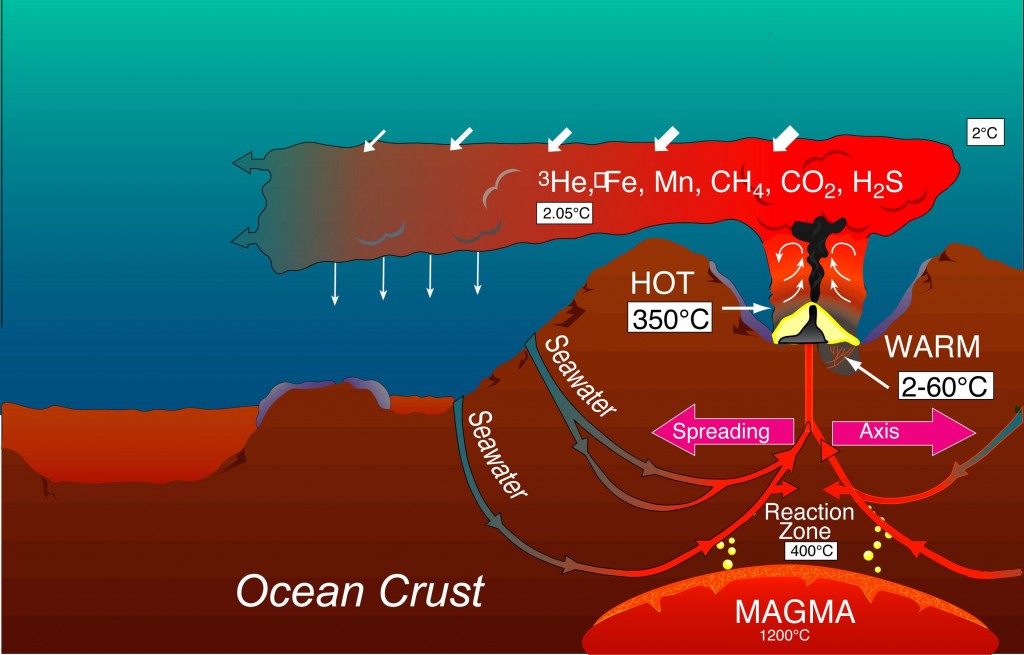25 November 2015
Tracking Down Hydrothermal Vents
Posted by lhwang
By Edward T. Baker
This is the latest in a series of dispatches from scientists and education officers aboard the Schmidt Ocean Institute’s R/V Falkor. This November, scientists aboard the research vessel Falkor will aim to shed light on the Mariana Back-arc, which is expected to be teeming with activity and life. Over the course of their 27 day mission at sea they will explore the back-arc spreading center to find new sites of hydrothermal activity and to better understand the physical, chemical, and geological forces that shape biodiversity in these unique ecosystems. Read more posts here, and track the Falkor’s progress here.
Tracking Down Hydrothermal Vents
Scattered along the barren ocean floor lie uncounted hydrothermal vent sites—oases of hot, chemical-rich, life-nurturing fluids. These oases are a submarine version of Yellowstone National Park. Cold seawater in deep cracks is heated by cooling magma, becomes buoyant, and rises to the seafloor. Instead of forming a warm pond, as at Yellowstone, the hot fluid rises like a hot-air balloon into the cold ocean, cooling as it mixes with the frigid seawater. Mixing continuously dilutes the hot discharge and increases its volume as it rises, until the hydrothermal plume achieves neutral buoyancy and is dispersed by the local currents. This hydrothermal circulation pattern occurs wherever seafloor cracks can channel seawater to layers of hot rock.

Graphic of a vent at a spreading center forming a hydrothermal plume (not to scale). Seawater penetrating cracks in the crust is heated by magma several kilometers deep. The heated seawater carries chemicals from the magma and the crustal rocks to the ocean. The discharging fluids are diluted by seawater, rise a few hundred meters, and are dispersed laterally by local currents.
Credit: SOI / Gary Massoth
First You Need a Good Map
Our task on the R/V Falkor is to hunt down where these sites lie along the Mariana Back-arc. No search can begin without detailed bathymetric maps that precisely define the shape of the seafloor. Seafloor bathymetry provides a road map that greatly narrows our search by identifying the path along the seafloor where the most recent seafloor spreading is occurring. On the Mariana Back-arc, seafloor spreading has created a broad valley whose size rivals the Grand Canyon. It is here where deep, still-molten, magma may be powering active vents.

Map of a section of the Mariana Back-arc. The black dashed line traces the axis of spreading, which has created a valley up to 10 km wide in this location. This valley is one of our targets for the discovery of hydrothermal vents.
Credit: SOI / Susan G. Merle
Hunting for Plumes
Our search is challenging because the active discharge orifices themselves are small, scattered, and difficult to find. We greatly enhance the chance of success by searching first for the telltale plumes the vents emit, and not the vents themselves. As a trail of wind-blown smoke draws the eye to a smokestack, oceanographers use maps of hydrothermal plume tracers that lead back towards a field of vents. The tracers can be physical measurements such as changes in temperature, salinity, and turbidity of the water. Chemical characteristics of the plume are also used, including various trace metals and gases common in a hydrothermal discharge.
To map these plumes we have two powerful tools. The first is a basic instrument, used by oceanographers around the world, consisting of a Conductivity-Temperature-Depth (CTD) package with specialized sensors to detect specific tracers, and bottles to collect samples. We tow the CTD behind the ship, a few hundred meters above the seafloor, as we slowly steam along the spreading center path, creating a map of likely vent locations. To precisely locate the vents themselves, we next deploy a better bloodhound. Sentry is a robot submarine, or Autonomous Underwater Vehicle (AUV), that can navigate precise grids over the seafloor, sniffing out the source of a hydrothermal plume. Ultimately, Sentry flies closer to the seafloor, making high-resolution sonar maps or capturing images of animal life and the hot springs themselves.

The CTD instrument package on R/V Falkor is lifted over the side for a test deployment.
Credit: SOI / Thom Hoffman
A year from now, when we return on the R/V Falkor with a seafloor-sampling vehicle, we will have detailed information on the location and characteristics of a suite of vent sites. Explorers now, we will next year spend our time on diligent investigations of the chemical, biological, and geological marvels of hydrothermal oases along the Mariana Back-arc.
— Dr. Edward T. Baker is a scientist studying hydrothermal vents at Mariana. For the past 30 years his research has concentrated on the creation and thermal evolution of vent fields created by seafloor eruptions, and the global pattern of vent field distribution along ridges and island arcs.











 GeoSpace is a blog on Earth and space science, managed by AGU’s Public Information staff. The blog features posts by AGU writers and guest contributors on all sorts of relevant science topics, but with a focus on new research and geo and space sciences-related stories that are currently in the news.
GeoSpace is a blog on Earth and space science, managed by AGU’s Public Information staff. The blog features posts by AGU writers and guest contributors on all sorts of relevant science topics, but with a focus on new research and geo and space sciences-related stories that are currently in the news.